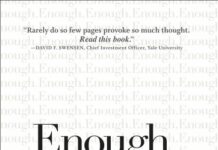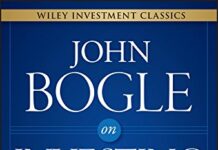
Ebook Info
- Published: 2017
- Number of pages: 287 pages
- Format: PDF
- File Size: 2.66 MB
- Authors: John C. Bogle
Description
The best-selling investing “bible” offers new information, new insights, and new perspectives The Little Book of Common Sense Investing is the classic guide to getting smart about the market. Legendary mutual fund pioneer John C. Bogle reveals his key to getting more out of investing: low-cost index funds. Bogle describes the simplest and most effective investment strategy for building wealth over the long term: buy and hold, at very low cost, a mutual fund that tracks a broad stock market Index such as the S&P 500.While the stock market has tumbled and then soared since the first edition of Little Book of Common Sense was published in April 2007, Bogle’s investment principles have endured and served investors well. This tenth anniversary edition includes updated data and new information but maintains the same long-term perspective as in its predecessor. Bogle has also added two new chapters designed to provide further guidance to investors: one on asset allocation, the other on retirement investing.A portfolio focused on index funds is the only investment that effectively guarantees your fair share of stock market returns. This strategy is favored by Warren Buffett, who said this about Bogle: “If a statue is ever erected to honor the person who has done the most for American investors, the hands-down choice should be Jack Bogle. For decades, Jack has urged investors to invest in ultra-low-cost index funds. . . . Today, however, he has the satisfaction of knowing that he helped millions of investors realize far better returns on their savings than they otherwise would have earned. He is a hero to them and to me.”Bogle shows you how to make index investing work for you and help you achieve your financial goals, and finds support from some of the world’s best financial minds: not only Warren Buffett, but Benjamin Graham, Paul Samuelson, Burton Malkiel, Yale’s David Swensen, Cliff Asness of AQR, and many others.This new edition of The Little Book of Common Sense Investing offers you the same solid strategy as its predecessor for building your financial future.Build a broadly diversified, low-cost portfolio without the risks of individual stocks, manager selection, or sector rotation.Forget the fads and marketing hype, and focus on what works in the real world.Understand that stock returns are generated by three sources (dividend yield, earnings growth, and change in market valuation) in order to establish rational expectations for stock returns over the coming decade.Recognize that in the long run, business reality trumps market expectations.Learn how to harness the magic of compounding returns while avoiding the tyranny of compounding costs.While index investing allows you to sit back and let the market do the work for you, too many investors trade frantically, turning a winner’s game into a loser’s game. The Little Book of Common Sense Investing is a solid guidebook to your financial future.
User’s Reviews
Reviews from Amazon users which were colected at the time this book was published on the website:
⭐A solid reminder of the basics and also gives you insight of many investing ‘rules’ you have heard but with no in-depth background of what they are truly trying to convey.
⭐I am not a stock broker or banker. But as a retired academic, I like to read the trade books- occasionally you get garner some real gems of experience. Remember that trade books are usually a 2 page thesis surrounded by 200 pages of commentary. My assessment:a. Heavily biased to index funds without any real fundamental explanations other than trends and statistics. You may have heard the claim that “correlation does not equal causation” if you’ve ever done research or tried to get an academic paper published. Nor does it seem to supply any real competitive analysis to other strategies such as value investing. It also seems to avoid any discussion of commodity markets.b. What happened in 1980s and 1990 does not apply today. We made money easily in those decades, if you stayed out of auto.c. Ignores the fact that the US and its companies are facing intense international pressure nowadays and all of its ramifications.d. What to make of this book- it sounds to me like Mr B. is making the same arguments I heard in 1980 when I worked in the tech sector. A lot of people ignored this book, saw Microsoft spreading across all desktop computers and did extremely well over 20 years. Contrary to Mr. Bogle’s claims- you only had to work in industry to see the herd mentality- “you won’t get fired by buying microsoft”.e. His review of Peter Lynch does not jive with my readings of Mr Lynch’s guidance on stock picking. I remember Mr Lynch’s admonition- stick with stuff you know or are in involved with personally or professionally. For example, i used to call on a customer in the Bay Area- they claimed they would beat the US Government to sequence the human genome. My brokerage firm offered me a few 1000 shares in their IPO- which I never buy. But having been to their company and talked among associates in Silicon Valley- it was a real no brainer. Clearly my single contrary example does not make a compelling argumentIn summary, its a good book that explains index funds but as for investment guidance- I plan to continue use common sense. Stick with stuff you know and use, and put this on the shelf.
⭐I can’t remember a lot of the info but it is good for beginner stock market traders.
⭐When someone as successful as John Bogle attempts to impart knowledge in the form of a book, people ought to listen and heed his advice. This is the man who practically invented the index fund, after all.While there’s much wisdom to be found in The Little Book of Common Sense Investing, the first third to half of the book is dedicated to discussing the sheer arithmetic of how actively managed funds eat away investors’ gains: fees, taxes, and all. I cast no doubts on the value of these discussions, particularly to readers for whom the topic of index fund investing is novel in its entirety. That said, this first part could have been significantly shortened without much loss to its value, if at all.After tackling the disadvantageous arithmetic of actively managed funds, Bogle dedicates a few more chapters to drive his point home and details how these funds consistently fail to match the returns of the index.Two-thirds into the book, commentaries on and new information about other matters such as investment advisors, bond funds, and ETFs finally surface. Beyond a critical assessment of non-index ETFs, little explanation of the tax differences between long-term index fund and long-term index ETF investing is offered before the book circles back to theme, with a section on what the great Benjamin Graham would have said about index funds promptly following.For the uninitiated, The Little Book of Common Sense Investing serves as a good resource to explain the how’s and why’s of index funds. For individuals who have read enough about index funds as to already be invested in them, however, four-fifths of the book may feel little more than one thick advertisement, living up to “The Only Way to Guarantee Your Fair Share of Stock Market Returns” well.But what about the last few chapters? This is where the earlier-mentioned “much wisdom” enters the equation, with Bogle providing timeless insights on assembling portfolios, building them efficiently, customizing them for retirement, and a myriad other ideas that can only come with maturity and experience. For these alone and despite all my ramblings above, I recommend alloting space in one’s collection and a few hours of one’s time for this book.
⭐This was presented in simple language and made a clear case for investing in indexed funds. It addresses the stock/ bond balance required for different stages,of life.
⭐A great manifesto to indexing! While it was a bit dry at times, that is to be expected of an investment book, in particular an investment book on passive indexing.My favorite part were some of the jaw dropping stats and figures he showed.
⭐If you want to learn a easy and good strategy this is the best book.A Must read!!!! I loved it!
⭐I heard of this book on an Investopedia articled titled “The 9 Best Books for Young Investors in 2021” that says: “If there’s only one book young investors need to learn about the stock market, retirement investing strategies, and real estate investment opportunities, we recommend “The Little Book of Common Sense Investing” by John C. Bogle.”Intrigued, I was expecting some sort of a guide on the stock market: some sort of “for Dummies” book but better.Instead, what I found was a finance-themed self-help book which, like all self-help books, stretches a single simple concept for 200+ pages.Here’s the gist of the book: invest in index funds, don’t waste your time and money by investing in single stocks or mutual funds.That’s it, I saved you 10 quids.The book introduces this concept in the first 10 pages and proceeds to bludgeon you on the head with it for the remaining 190 pages. All the while relentlessly pouring unfunny jokes, quotes from Warren Buffet (if I wanted to hear from him I would’ve gone to the source thanks), and the author’s unbearable self-aggrandizing as a “pioneer” of index funds. That’s right, the author has a vested interest in index funds since he created Vanguard, one of the most famous index funds.Basically with this book you’re buying an ad.If there’s an upside from this situation is that from now on I won’t every buy a stock market book again: I will just borrow ebooks from the library and read them on my non-Amazon ereader.Stay away from this total scam.
⭐This book is just an advert for vanguard investment services. I’ll save you the time and money of reading it: the books core message is buy low cost index funds and hold them forever.If you actually want to learn how to trade stocks and shares, don’t buy this book. It’s a complete waste of time.
⭐If you heard about investing (usually a sign we’re in a bubble or getting there) and you’re thinking of start investing you should start with this book.It makes a really compelling argument for investing using an index fund and saving time and energy for other things you may enjoy more than researching companies, etc.Over the long terms:- Costs compound badly- Active investors on average fail to produce good results because of the costs of trading and CGT (Capital Gain Taxes) expenses- By buying an index you reduce the emotional stress and you’d be less likely of panic or get greedyFor some reason I still think the book is missing something in terms of preparing the reader for the frequent and normal up and down of the markets.
⭐I wish I had come across this book in 1996, when I first started investing in funds. At the time, I was living in the US, where most pensions are defined contribution and require you to take charge of where your contributions are invested. Over the years, I have made the following errors: (1) investing in individual companies; (2) investing in “fads” (specifically, tech funds in 2000!); (3) not learning enough about bonds; (4) having a portfolio that was unbalanced in terms of equities and bonds, geographic regions, and sectors; and (5) not paying attention to fund costs.Over the years, I have learned these lessons slowly but surely (and sometimes painfully!) I can honestly say that if I’d had this book back in 1996, I wouldn’t have made nearly as many mistakes.In the 1970s, John Bogle was the visionary that understood that the best strategy for almost every investor who is in it for the long haul is to invest broadly in index (tracker) funds with low charges. That’s it! Sounds simple, and if you don’t want to spend 14 quid on the book, just do this. But in comparison to the long-term costs of investing, 14 quid is nothing, and the book will help you understand WHY this is such a good long-term strategy. Using numerous data-based examples, Bogle illustrates why this works, and the pitfalls of not following it. All the data show that “expert” stock-pickers do no better than chance, compared to index funds, and because of factors such as reversion to the mean, and of course higher costs, they do worse.I read this book in just 2 days. Besides maybe Dave Ramsay’s book “Financial Peace”, it is by far the easiest book on investment that I have ever read. Considering the move within the UK towards defined-contribution occupational pension schemes, it should be required reading.
⭐I’ve seen criticism of this investment classic book that it is too repetitive about its key message: invest passively in index funds with low fees (like those that this late author offered at vanguard). If so then you don’t waste time and money chasing the market or paying fees to active fund managers. The critics have no idea of how much good this book have done for investors despite it’s simple idea, not only when it was first published but still today where too many people do turn a winers game into a losers game as the author alerts to by chasing high reward whose promises comes with high risk. It makes sense that Boggle repeats over and over a myriad of arguments in favor of index funds and against risk because most people fall for it even if they cannot afford to lose or are not young enough to recover from risky investments. Avoid and ignore his arguments at your own peril.
Keywords
Free Download The Little Book of Common Sense Investing: The Only Way to Guarantee Your Fair Share of Stock Market Returns (Little Books. Big Profits) in PDF format
The Little Book of Common Sense Investing: The Only Way to Guarantee Your Fair Share of Stock Market Returns (Little Books. Big Profits) PDF Free Download
Download The Little Book of Common Sense Investing: The Only Way to Guarantee Your Fair Share of Stock Market Returns (Little Books. Big Profits) 2017 PDF Free
The Little Book of Common Sense Investing: The Only Way to Guarantee Your Fair Share of Stock Market Returns (Little Books. Big Profits) 2017 PDF Free Download
Download The Little Book of Common Sense Investing: The Only Way to Guarantee Your Fair Share of Stock Market Returns (Little Books. Big Profits) PDF
Free Download Ebook The Little Book of Common Sense Investing: The Only Way to Guarantee Your Fair Share of Stock Market Returns (Little Books. Big Profits)


